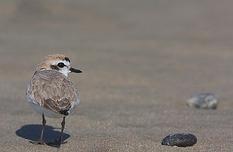 By Oregon Department of Fish and Wildlife,
By Oregon Department of Fish and Wildlife,
SALEM, Ore.—The Pacific coast population of the western snowy plover, a small shorebird which is listed as threatened under both federal and state Endangered Species Acts, appears to be responding to recovery efforts in Oregon but remains vulnerable according to data from a 2009 population survey.
Results from this year’s field survey indicate that as many as 201-208 individual birds were recorded along Oregon beaches between April and September, the highest number detected since monitoring began in 1990 when biologists estimated there were only 50 adult plovers in the same area. Reasons for the decline of the once widespread species include human development, loss of nesting habitat to non-native European beachgrass and poor reproductive success resulting from human disturbance and predation.
“This year’s data is really encouraging. It appears that the work we’ve been doing with habitat and predator management is helping,” said Dave Lauten, wildlife biologist, Oregon Natural Heritage Information Center, Oregon State University. “A lot of the thanks has to go to beach visitors who help out by observing signs and leashing their dogs to give plovers space to successfully nest and rear their young.”
Public support for the plover is important as one of the biggest challenges to ongoing recovery of the species is keeping plover nests intact through the breeding season—safe from walkers, dogs and vehicles.
Predators such as fox, crows, ravens, skunks and deer mice, which seek out plover eggs and hatchlings, also take a toll. While 2009 surveys found 236 nests, the highest number since the surveys began, the real measure of success is how many nests produce fledglings. In 2009, overall nest success was relatively poor, with only 106 chicks, or 33 percent of hatched chicks, surviving to independence.
Recreation, predator and habitat management are among the strategies outlined in the species’ Recovery Plan. Habitat work includes removal of invasive beachgrass to create native open dry-sand areas and remove places for predators to hide. The plan, which was released in September 2007 by the U.S. Fish and Wildlife Service, is available on their Web site. An Oregon and Washington interagency team including staff from the U.S. Bureau of Land Management, U.S. Forest Service, Oregon Park and Recreation District, U.S. Fish and Wildlife Service, Oregon Department of Fish and Wildlife and Oregon Natural Heritage Information Center has worked for the recovery of the species since the early 1990s. The recovery goal is 250 breeding snowy plovers with an average of one fledged chick per male along the Oregon and Washington coasts.
The Snowy Plover
The western snowy plover is a small shorebird, about 6 inches long, with a thin dark bill, pale brown to gray upper parts, white or buff colored belly, and darker patches on its shoulders and head and white forehead. For more information on the species, visit the U.S. Fish and Wildlife Service Web site.
The western snowy plover is identified in the Oregon Conservation Strategy as a species in need of conservation help. For more information, see the Coast Range ecoregion section of the Strategy on the Oregon Department of Fish and Wildlife’s Web site.
###
Disclaimer: Articles featured on Oregon Report are the creation, responsibility and opinion of the authoring individual or organization which is featured at the top of every article.


